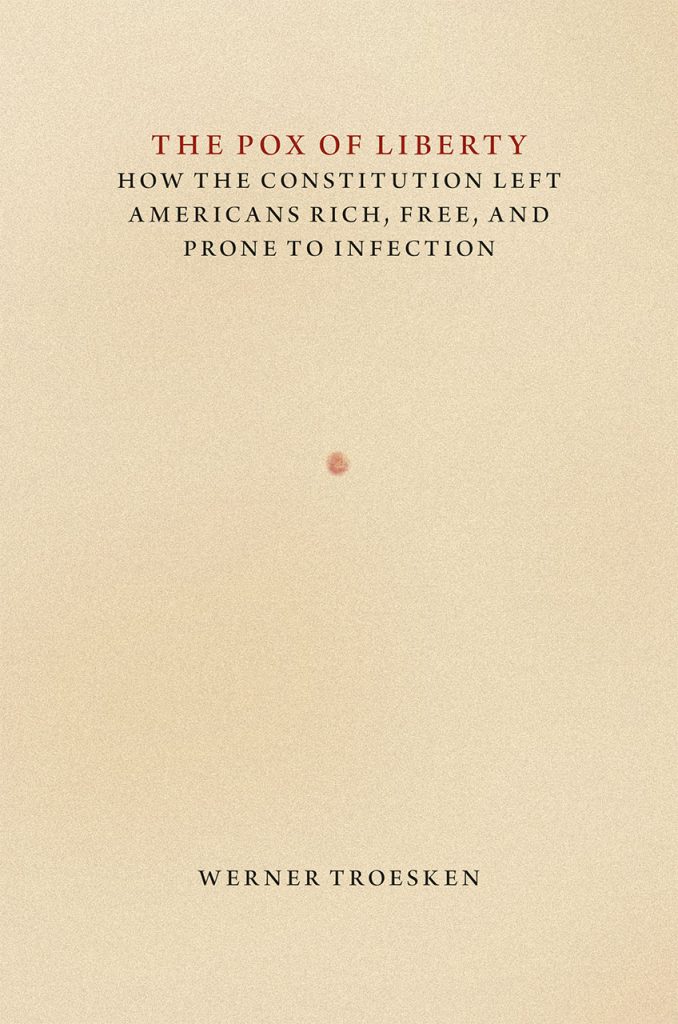Price V. Fishback on Werner Troesken’s “The Pox of Liberty” and Our Current Tradeoffs between Quarantines and Economic Freedom
Economist and Press author Price V. Fishback shared with us recently his thoughts on a previous Press book that speaks to our current situation and looks at the political and economic history of how the US government has responded to other pandemics.
The current crisis has brought into focus the tradeoffs between quarantines and economic freedom. For an excellent book about the history of these tradeoffs in the United States, read Werner Troesken’s The Pox of Liberty: How the Constitution Left Americans Rich, Free, and Prone to Infection (University of Chicago Press, 2015). Werner traces the history of how governments at all levels of the American federal system dealt with three deadly and recurring diseases: smallpox, yellow fever, and typhoid. All of the issues the world is facing today to avoid horrid deaths are discussed in Werner’s book: inadequate testing, the absence of vaccines, attempts to develop vaccines, tradeoffs between economic losses and quarantines, the uncertainties that the disease might return in the future, and inadequate medical facilities. The situations developed in the nineteenth-century societies when there were much higher death rates, lower incomes, and at best rudimentary medical care.
In his preface, Werner says that he started out trying to answer the question: “How and why have some societies come to control infectious diseases while others have let them fester?” He originally thought the answer was simple. The difference was good governance and good governance came from democracy. As he studied the history of epidemics, however, he discovered the situation was more complex. Some political institutions often thought to promote desirable political and economic outcomes, which can also hinder the provision of public health and vice versa.
The Commerce and Contract Clauses of the US Constitution, for example, were designed to address the problem of powerful political lobbies seeking to capture the government to use it to support their own ends at the expense of broader societal welfare. In terms of economics and politics, these and other institutional controls had many desirable features. The Commerce Clause fostered competition among jurisdictions for businesses and residents, giving rise to an optimal mix of taxes and public goods. Similarly, the Contract Clause prevented state legislatures from altering the terms of contracts, particularly debt contracts, after the fact, and this helped to revive American credit markets.
BUT these Clauses also directly impacted the provision of public health, for bad and for good. When combatting yellow fever, the Commerce Clause and the federal structure of governments at times obstructed the development of a coherent and rational system of quarantines. They also allowed people who wanted to avoid vaccines to come together in small communities and make it more difficult to achieve the goal of universal smallpox vaccination in America. On the good side the federal structure of government, the Commerce Clause, and the protection of contracts allowed local governments to issue debt that made it possible to construct large and expensive public water and sanitation systems. When taken in the aggregate, these systems likely were the largest public investments in American history. Further, they had larger impacts on reducing death rates than any other public health initiative.
Werner also sought to highlight how ideas about politics, economics, and science interacted to shape the American disease environment. He describes how the American commitment to commerce and the rise of the germ theory of disease transformed the public health system in the United States, moving it away from one based on volunteerism and private action at the municipal level, to one that was more national in scope and involved much more state intervention. Of particular importance is how the American quest for trade gave rise to large port cities that were vulnerable to diseases like yellow fever, and how the quest for trade gave rise to a stronger government that helped eradicate yellow fever once and for all. Ironically, the federal government was more successful and aggressive in its efforts to control yellow fever abroad than it had been at home. For its part, the rise of the germ theory of disease had its largest impact on the structure of municipal government, inspiring a wide range of public health programs and fostering growth in both the size and scope of municipal governments, particularly public water and sewer systems.
Ultimately, Werner shows how the clauses of the US Constitution that expanded freedoms served to make it more difficult to prevent disease in the short run. Yet, in the long run, these same clauses provided expansive opportunities for a wide range of governments, people, and organizations to increase incomes and find ways to solve the disease problems. It is a complex story that weaves together law, economics, politics, sociology, demography, and epidemiology into a superb tapestry by one of the leading economic historians of public health. Sadly, Werner died in 2018, so we cannot talk to him directly, but his writing offers a valuable history lesson for how to think about the issues the world faces today.
